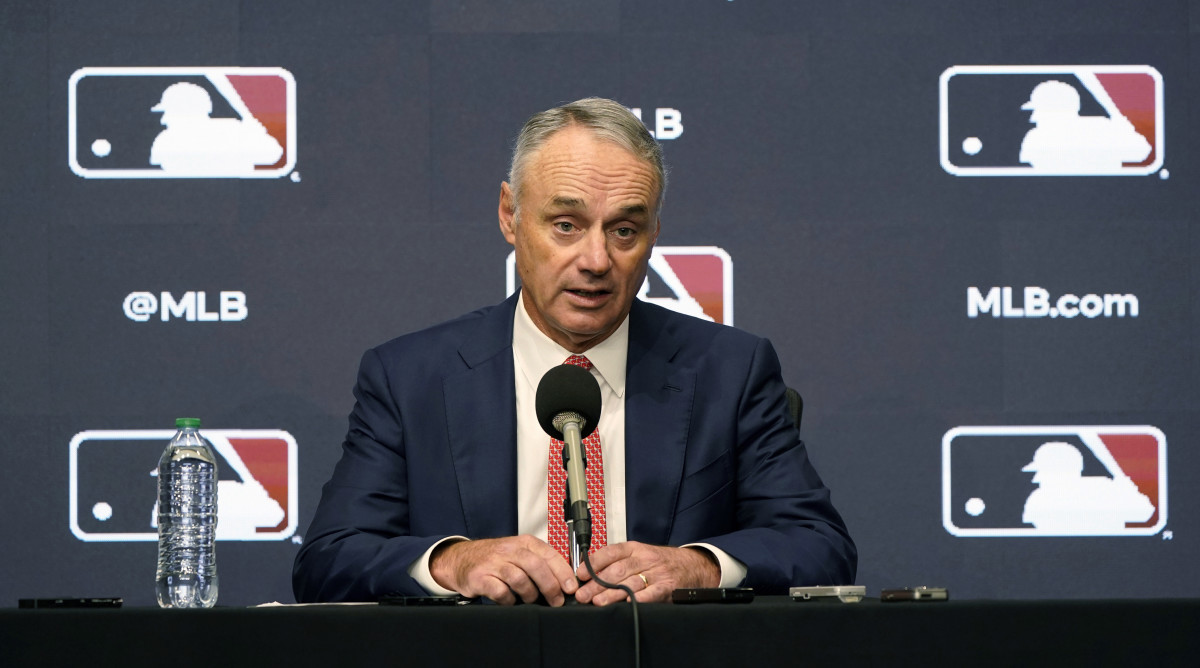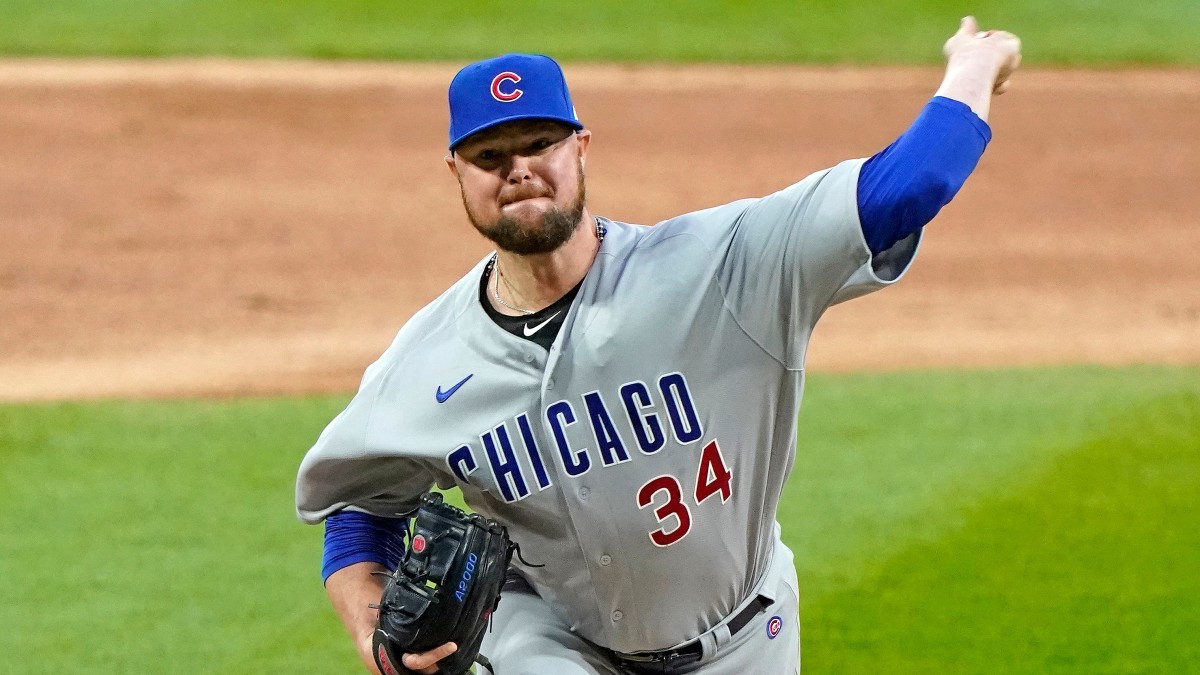What You Need to Know As Baseball Resumes Bargaining

The most revealing takeaway from yesterday’s bargaining session between MLB and the MLB Players Association was summed up succinctly in this quote from one person with the union to Sports Illustrated’s Stephanie Apstein: “Well, what did you expect?”
Not much.
It was the first substantive conversation between the two sides in 43 days, longer than Jesus fasted in the Judaean Desert. It would’ve taken an even greater miracle for a deal to come out of yesterday’s meeting.

MLB made some economic proposals, including a formula to pay more to all players with two-plus years of service, not just those who qualify for Super Two arbitration, according to SI’s Tom Verducci. The league also made a proposal to address the union’s concerns about service-time manipulation, along with one to adopt an NBA-style draft lottery to disincentivize tanking, per Verducci.
The players were not impressed. Why should they be? Giving all players with two-plus years of service time more money is a good thing, in theory. But the union is wary about any proposal that would eliminate or reduce arbitration eligibility, fearing that it would set a precedent for the league to roll it back further in future CBAs. Instead, the players want to negotiate for higher minimum salaries for pre-arbitration players while retaining the ability to earn more through arbitration once they are eligible.
It looks like a draft lottery will be in the final agreement, though the two sides still are not in agreement about its specifics. The league wants only the top three picks to be decided by the lottery; the players want the lottery to include the top eight, according to Evan Drellich of The Athletic. My guess is the lottery will end up in the middle and include the top five picks.
The most laughable part of the league’s proposal yesterday was its idea for addressing service-time manipulation, which the owners still have not actually admitted to doing.
Quick refresher: “A player is deemed to have reached ‘one year’ of Major League service upon accruing 172 days in a given year,” according to MLB.com’s definition of service time. Players become eligible for free agency at the end of the season in which they reach six years of service time. Organizations have manipulated the service time of their top prospects by leaving them off the 40-man roster long enough at the start of the season to keep them under club control for an extra year.
The most prominent (read: egregious) example of this was when Kris Bryant, then the No. 1 prospect in baseball, started the 2015 season in Triple A despite his raking at every level of the minor leagues and hitting .425/.477/1.175 with nine homers in 14 spring training games that year. The Cubs called him up to make his debut on April 17, when there were exactly 171 days left in the season.
MLB’s solution? Reward the teams that follow the rules without punishing the ones who manipulate service time. Here are the specifics for how this would work, as Sportsnet Canada’s Ben Nicholson Smith reported on Twitter: “[I]f a highly-ranked prospect (within top 150 on prospect lists) plays a full year and finishes top five for a major award like MVP, Cy, RoY his team would get a bonus draft pick.”
Yeah, that’s not going to happen. Most likely, neither is the start of spring training in about a month. The two sides haven’t made progress on other key economic issues, such as the collective balance tax thresholds and penalties, free agency and revenue sharing, all of which will be far more contentious than implementing the universal DH (which almost certainly is coming in 2022) and a draft lottery.
For now, we wait. First, we’ll argue about the Hall of Fame. And watch the NFL’s first Super Wild-Card Weekend and the rest of the playoffs (go Rams!). And follow the latest in the Klay Thompson saga. Then the calendar will turn to February, still with no baseball. We’ll reunite with friends for Super Bowl parties (safely, I hope). And go nuts over the Winter Olympics. And wonder if maybe, just maybe, this is the Knicks’ year after all. Still, no baseball.
The real deadline for an agreement, as Verducci wrote yesterday, is around March 9; any later and the regular season will be delayed and, most definitely, shortened. My guess is there will be a new CBA right around then. Nothing forces hands quite like a deadline, and the sport cannot afford to miss games. But as each week passes us by between now and then, and so many other events in the sporting world compete for our collective attention, it’s worth considering whether games are the only thing it can’t afford to go without.
Before we continue, a quick correction from last week’s newsletter. In the initial version that was sent out over email, I wrote that Mark Teixeira “is one of four players to hit 400 homers and win five Gold Gloves.” I left out a crucial piece of information. It should be one of four non–Hall of Famers. My apologies!
1. THE OPENER
“In the minutes after the first substantive conversation between Major League Baseball and the Major League Baseball Players Association in 43 days, some two dozen players gathered on Zoom to discuss the proposal they had just heard. Sometimes such caucuses can devolve into swearing, screaming sessions. But this one was more relaxed, according to a person familiar with it. The players were not excited about the league’s latest offer. But they were not furious, either. A second person characterized their reaction as ‘disappointed,’ a third as ‘frustrated.’”
That’s how Stephanie Apstein begins her column, in which she explains that the most important thing about yesterday’s bargaining session is that there was one.
You can read here entire story here:
2. ICYMI
The bargaining session was the highlight of a fairly eventful baseball week, considering it is still in a lockout:
MLB and the MLBPA Still Have a Long Way to Go by Tom Verducci
Progress and common ground have been so rare that the scheduled start of spring training could be jeopardized.
Jon Lester, one of the most successful pitchers so far in the 21st century, announced his retirement this week:
Jon Lester’s Epic Baseball Story Comes to an End by Tom Verducci
The former Red Sox and Cubs ace is retiring after 16 seasons, three World Series titles and 200 wins. Few pitchers get to impact MLB history the way he did.
More news from this week:
The Yankees hired Rachel Balkovec as the manager of their Low-A affiliate, the Tampa Tarpons. She is the first woman manager in the minor leagues.
The Red Sox hired Katie Krall as a developmental coach for the Double A Portland Sea Dogs, making them the first organization with two women minor league coaches, along with Bianca Smith, who last year became the first Black woman to coach in affiliated baseball. As The Boston Globe’s Alex Speier wrote, Smith initially was hired on a seasonal contract but took on more responsibilities as the year progressed. She will be a full-time coach with the Florida Complex League Red Sox in 2022.
Also, the Atlantic League announced it will be returning its pitching rubber distance to 60'6" from home plate after it had moved the rubber back a foot for the second half of last season. It also will use human umpires again to call balls and strikes after trying out an automated strike zone.
Here are the rest of our baseball stories from this week:
Hall of Fame Tracker Is Improving the Cooperstown Conversation by Emma Baccellieri
In cataloguing BBWAA ballots before the final results are announced, Ryan Thibodaux and his team have transformed how we think and talk about the voting process.
Bonds, Clemens, Schilling, Sosa Have Two Cracks at HOF in 2022 by Tom Verducci
Should they immediately push others off the crowded ballot of the Today’s Game Era Committee, and do they stand a better chance of getting elected there?
How Each NL Playoff Team Can Fix Its Most Pressing Needs by Will Laws
Here’s what the Braves, Brewers, Cardinals, Giants and Dodgers need to address when the lockout ends.
Emma Baccellieri will be doing another mailbag in next week’s newsletter, so if you have a question you would like answered, send it to mlb@si.com, or hit her up on Twitter @emmabaccellieri.
3. WORTH NOTING from Stephanie Apstein
Once the league locked out the players, it erased all traces of them from its website. But as players retire, they cease being members of the union—which means they can exist again, as far as the league is concerned. So expect a lot of celebration on MLB.com of Kyle Seager, Jon Lester and Melky Cabrera.
4. TRIVIA! from Matt Martell
Before we get into this week’s question, here is the answer to the one I asked last Friday.
Last Week’s Question: Mark Teixeira is one of five switch hitters with at least 400 home runs. Can you name the other four?
Last Week’s Answer: Mickey Mantle (536), Eddie Murray (504), Chipper Jones (468), Carlos Beltrán (435)
This Week’s Question: There are five active players with at least 2,000 career hits. Can you name them?

5. THE CLOSER from Emma Baccellieri
Happy trails to Jon Lester, who announced his retirement this week at the age of 38. A future Hall of Famer? Most likely not. But he leaves behind a remarkable body of work (three championships and surviving cancer), which includes being one of just five pitchers so far this century to rack up 200 wins with an ERA under 3.75. (His company there is CC Sabathia, Justin Verlander, Zack Greinke and Tim Hudson.)
That’s all from us today. We’ll be back in your inbox next Friday. In the meantime, share this newsletter with your friends and family, and tell them to sign up at SI.com/newsletters. If you have any questions or comments, shoot us an email at mlb@si.com.
